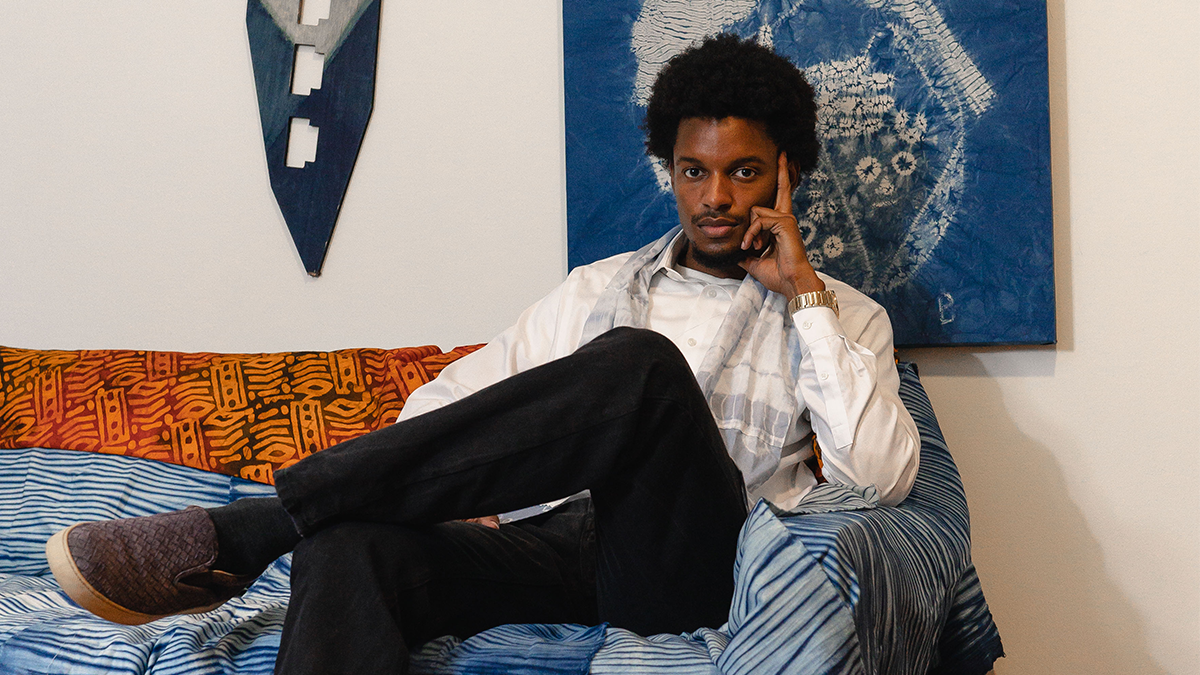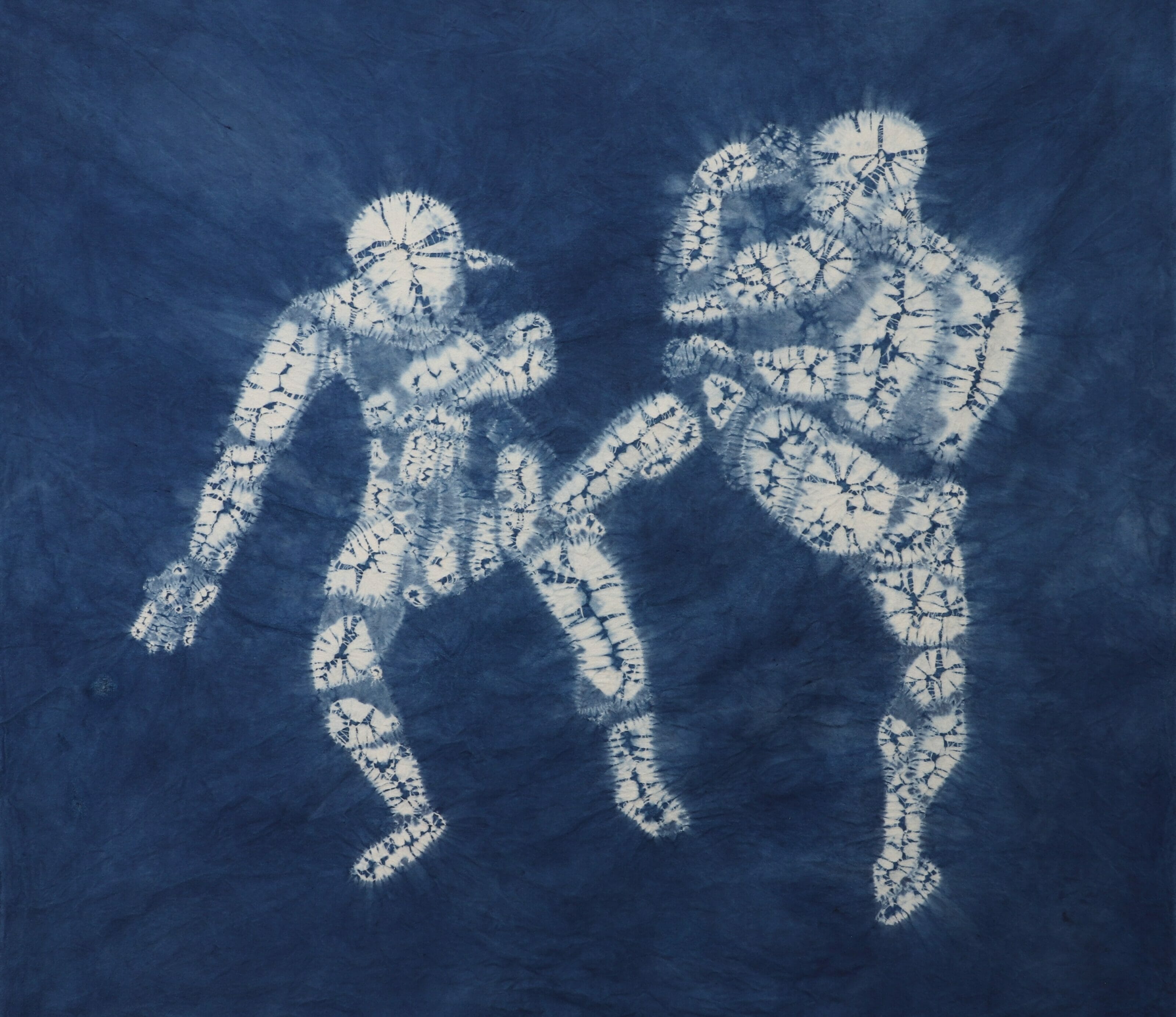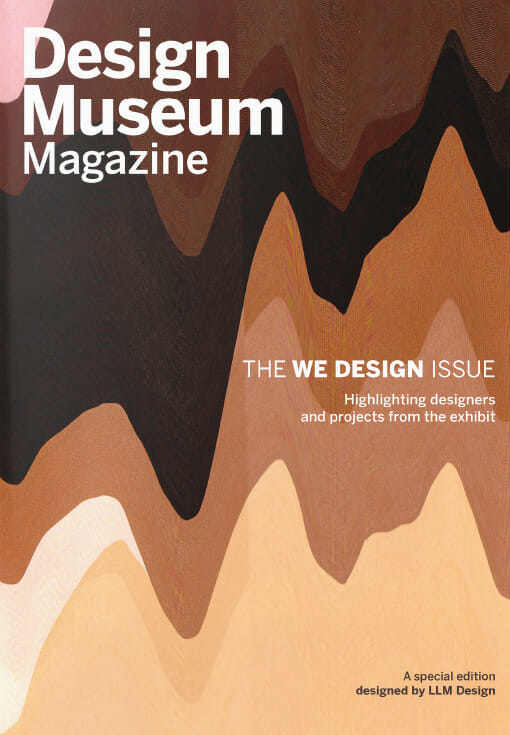Love Sourcing: Finding Sustainability Through The Intangible

Bakari Akinyele with indigo dyed textile art pieces.
By Bakari Akinyele, Strategist and Artist
One year ago, my mother gifted me a vibrant, orange, and brown, hand-dyed batik cloth made by her friend, a 5th generation Ghanaian master batik dyer. The cloth travels with me everywhere. I use it to adorn my living space, and occasionally I wear it myself. A good life includes living with beautifully crafted objects in my family tradition. The value each object holds is augmented by the intangible experiences and memories attached to them. It is just as art critic Soetsu Yanagi describes in The Beauty of Everyday Things, “The importance of living with beautiful everyday objects is to experience a sense of content.” Though I am a young Black man living in the height of a climate crisis so threatening, so urgent, and so ugly, I have a right to live a life with beautiful things. Responsibility for the climate crisis is frequently placed on the shoulders of the everyday person. Communities are encouraged to use less, recycle more, and minimize their carbon footprint. While these are good suggestions, it is existing ways of design thinking that need to be critiqued. The climate crisis has been caused by design that supports the relentless exploitation of our environmental, human, and material resources. To me, design should be the process of discovery, healing, adding value, and developing relationships.
My understanding of design theory and material culture comes from everyday people. My grandfather learned to create his own tools. When my favorite childhood blanket became too small for my body, my mother repurposed it into a pillow. My father taught me how to build my own clubhouse from discarded plywood. When one of my favorite shirts suffered a spaghetti stain, I overdyed it to give it new life.
My multidisciplinary education in design allows for a synthesis of personal experiences into a design technique and aesthetic that supports my vision of design in the postclimate crisis future. A large part of my design process is deconstructing imagined objects and processes, to determine how to use energy and materials effectively. When designing an object or process, I ask myself what is necessary for the object or process to be relevant, valuable, and useful in the postclimate crisis future? There are thousands of physical materials available to create with, but there is only one material that is truly sustainable. Love. A love composed of intention, care, compassion, and unbounded empathy towards our environment and the users we serve with our designs.
One day in undergrad, I was sitting in my room trying to figure out what I would do with my life post-graduation. I gazed at the batik dyed cloth my mother had given me and realized I was looking at the answer. If I mastered a specific step in the process of making textiles and applied an eco-conscious, love-forward approach, I would be able to traverse a multitude of industries from furniture design and automotive design to fashion.
I had the opportunity to visit a traditional textile artisan fair in Mexico City, where I connected with talented designers, artisans, and artists from around the globe. Getting to know them and their practices, I was inspired to research the integration of traditional crafts and contemporary design. The more I researched, the more I became aware of the accessibility barriers to learning about design.
Shortly after graduating from Howard University with a B.A. in Political Science and Philosophy in 2020 (at the start of the pandemic), I moved to Seoul, South Korea, as a Henry Luce Scholar. I spent ten months there researching design and traditional crafts practices in South Korea. I was able to observe the lineage and transformation of crafts in that environment. I had come to Korea with the intent of focusing on how craft objects, particularly soft goods like fabrics, clothes, and automobile interiors, were designed and made. My goal was to learn traditional and contemporary methods of designing that promote healing the self and the environment. I spent much of my time studying traditional Korean natural indigo dying and traditional South Korean embroidery techniques. As an artist and designer, getting the holders of my handiwork to truly appreciate the object beyond materiality is difficult. Surveying traditional crafts that had lasted hundreds of years to determine what would sustain this appreciation seemed like the obvious answer.

Bakari Akinyele, Capoieristas (1825). Movement Series. Cotton canvas dyed with natural indigo, 2021.
But great design still needs to meet changing modern needs. I conducted a market analysis of South Korean fashion trends and styles. Then, based on my research, I designed a modern version of a men’s Hanbok, a traditional South Korean garment for daily use. The garment is suitable for travel and reflects my practice as a pilgrim of design, traversing a globalized world. I taught myself how to make the techpack, 3D patterns, and material sourcing, and I carried out the remainder of the project to finish garments with the help of a local seamster.
Value lies in the practice. Materials aren’t inherently valuable; it is our relationship to the material that gives it a perceived value. Popular American media exposed me to the suggestion that fulfillment came from amassing as much as one could stuff into their home, whether it held sentimental value or not. This practice is inherently harmful to the environment and our perceptions of use and ownership.
Yanagi believed that the appeal of using a beautiful object is that you come to love the practice of engaging with the object. For example, tea ceremonies in South Korea and Japan have become synonymous with the vessels in which tea is consumed. Materiality holds less importance when something intangible is attached to the material, such as emotions and memory. These intangible materials are critical components of my design practice and sustainability research. After reading All About Love, in which bell hooks describes her journey to understanding love, I was reminded that love is practiced in all aspects of life, including design. While material qualities and their impact on the earth are important considerations, deep feelings—love in particular—are the only things that are positively sustainable.
Then how do we communicate love through design and creation? Master artisans show us that slow making, attention to detail, and spending time with the object seems to be the answer. Sew to make sure every thread is in its proper place. Unbind as opposed to cut to preserve as much material as possible. This attention to detail communicates that the maker loved the process. As an artist and designer concerned with communicating love, I hope that the person who holds what I make explores all of the details and loves it just as much if not more than me.
The mud-dyed cloth that I have loved since my mother gifted it will eventually become an heirloom once I give it to my children or grandchildren. I imagine wrapping them tightly in the cloth while recounting its numerous stories. Alternatively, I’ll use it to set the dining room table for special occasions. Regardless, the cloth becomes a medium by which I can communicate my love for them. They’ll sit and scan the numerous lines and patterns and etch the texture and smell into their memory. When I design an object, I try to imagine a future in which the object will still have use. The more uses an object has for expressing love in the future, the more valuable my designs become. Therefore, when I design, I reference the heirloom objects around me; as an example, an object that has survived up to the present moment and will continue to survive with care.
Heirloom objects help ethnoarchaeologists describe the values of previous societies. In addition, the techniques applied to the object teach them about the technology available, materials available, and even the maker’s values. The way heirloom objects are treated displays love as a value. Various mending techniques such as overdyeing or quilting can give a precious but damaged textile new life. Creators must design the object to allow the forthcoming generations to continue mending, caring for, and loving the object through their practices.
The mending portion is a key component to the sustainability and insurance that the object survives into the post-climate crisis future. Some materials can survive several lifetimes. However, their near indestructibility creates environmental challenges, including the disposal of hazardous waste or the slow release of microplastics into the air and water. Well-designed objects should reflect the needs and desires of the users, time, and environment. Materials that aren’t biodegradable and survive old ideologies require a complex system for recycling that would use more energy than natural cycles provide. Mending translates the love of the current user and allows for greater adaptability and change. Even if the original designer and user are absent, these marks and stitches serve to communicate how the object can continue to be used. Even if this is not possible, the physical material choice should allow it to decompose safely.
The childhood blanket, now pillow, was the first textile that I lived with consistently. It served as my mediator for sleep until I reached adolescence. Even then, I still held the memory of the blanket. When its original purpose no longer served me, my mother manipulated it to suit a new need. This example of adaptable design, mending, and love in practice makes room for the object to continue to have use in the future. Even if the blanket doesn’t make it to another user, the natural and chemical-free materials make it clean enough to be safely recycled.
My goal is to create an object that communicates my love for design. Furthermore, I want this love to transfer through the object to the user. The presence and awareness of love encourage the user to engage with my designs continuously through a practice, ritual, or ceremony, developing a relationship between user and object and supporting the continued use of the object. The moment the object breaks or becomes dysfunctional, mending occurs and continues to strengthen the relationship and intention that will carry the object into the future.
My design journey has had unexpected lessons. I realized that part of my design practice, which involves dyeing and embroidery, is the adornment of an already constructed object. Dyeing breathes new or renewed life and color into the textile. Embroidery, with the right techniques, has fortifying and mending capabilities. The cloth my mother gave me will get damaged at some point, but this presents the opportunity to further adorn, fortify, and charge it with love. The future of design thinking should incorporate love and practice at each step of the process—for example, ideation, prototyping, making, creating instructions, and sharing. Love is the greatest tool that designers have at their disposal to create lasting and effective change. Being a steward and designer of love will lead to well-made and beautiful objects that give users a sense of gratitude and happiness.
